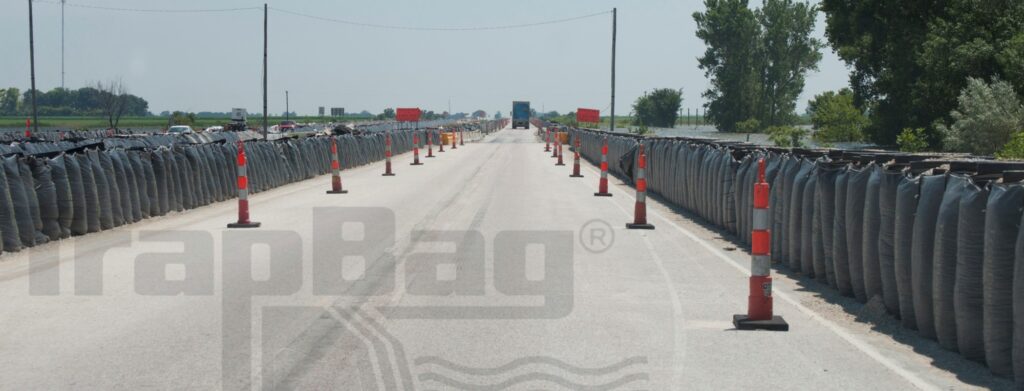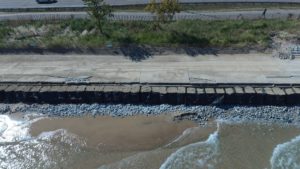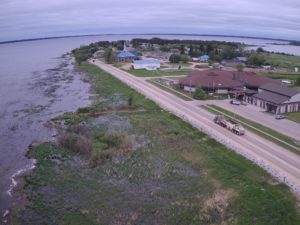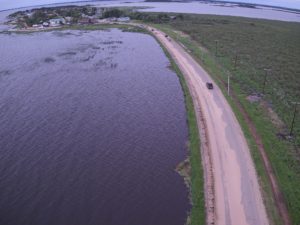Using TrapBags as Temporary Barriers
TrapBags® can serve as a reliable temporary barrier solution to flooding, erosion, spill control, coastal construction, and along shorelines.

Protect & Preserve with Temporary Barriers
Temporary barriers like TrapBags® can be utilized in a wide variety of situations to offer stabilization and protection in construction and environmentally-focused projects. The goal is to reduce the amount of sediment moving at the construction site near any easily erodible location. This includes bodies of water, bluffs, and other large sediment structures.
TrapBags act as a cofferdam to contain water, or even dewater an area in some situations. These temporary dikes are constructed to pump water out of an enclosed area and create a dry working environment at the construction site. One in place, construction crews will be able to excavate, repair, and pour concrete in the area safely without harming the nearby environment.
Temporary vs. Permanent Barriers

Temporary barriers are a convenient alternative to permanent options. They protect an area of soil from the surrounding water to allow for the proper and safe construction of dams, bridges, buildings, and other structures.
Because project lengths will vary, having a temporary barrier option serves as a money-saving method. Instead of paying for a permanent erosion barrier that will only be needed for a short amount of time, a temporary dam made up of TrapBags is the best option. TrapBags also ensure that once the construction project is completed, the aesthetic of the environment will remain untouched.
There are two divisions of temporary dams. Single wall dams are used in small areas with a depth of about six meters. A popular use of single wall dams is bridge construction. Double wall dams are utilized to improve stability in situations where the area is large and unable to be fully enclosed. Depending on the project, TrapBags are a perfect alternative to these methods.
Where Are Temporary Barriers Needed?

Various professions can apply temporary barriers in their work as a convenient solution to flooding and erosion during a construction project.
- Construction sites: Cofferdams allow for the safe and proper construction of a range of structures. From support walls and piers to highway ramps, tunnels, and even buildings, these temporary construction barriers keep crews, as well as equipment and materials, protected from potential flooding and erosion. Underground and above ground projects will all benefit from this added layer of security during the building process.
- Marinas: When building and repairing watercraft, chances are high that you’ll be surrounded by water or unstable soil. Cofferdams can control sediment near excavation sites and can also be used to dewater an area before construction begins. Streamline your system with the help of TrapBags, the affordable solution for construction near water.
- Flood zones: TrapBags are easy to move and place, meaning even in an emergency flood situation, they can be quickly deployed. The TrapBag system isn’t a Rolex watch, meaning sometimes water can find its way through very small cracks in the ground or surface. In projects which hold high importance on keeping the area as dry as possible, these small leaks can be combated with an attached HDPE visqueen liner. The liner runs down the vertical side of the TrapBags and out on the ground about 10ft from the barrier. Once water gets on the liner, the pressure holds the liner down on the ground.
- Chemical plants and/or factories: TrapBags can ensure water from nearby waterways or floods will not breach local chemical plants and factories. The alternative could end with devastating results, so having a solution like temporary barriers ahead of time can save lives, homes, and businesses.
- Areas prone to coastal erosion: In regions prone to erosion disasters and mudslides, TrapBags work as a control barriers to prevent the flow of debris and heavy waters. They also add stability to dangerous slopes and slow or even prevent flash flooding in locations close to waterways like streams and rivers. This redirection of water flow and land erosion can save homes, businesses, and families while protecting the nearby environment.
TrapBags as Temporary Barriers
TrapBags for Coastal Construction
Coastal construction is so much more than just construction along a coast. They tend to come with additional risks in comparison to typical construction projects. Temporary construction barriers like TrapBags will help in areas with high flood levels, wave action, and other coastal concerns. Erosion along a coast can destroy entire buildings, infrastructure, roads, and land. High winds mean any rain will cause quick concern at the site of construction. TrapBags protect land and infrastructure by creating a dam in the area of the coastal build.
TrapBags as Spill Control
In devastating situations like oil spills and chemical spills, TrapBag barrier reservoirs are a speedily deployed solution to quick-moving contamination. They’re durable and can be paired with an HDPE Visqueen liner to combat small leaks, keeping all contaminants confined to one area and preventing spread. This allows cleanup to happen while minimizing the spill’s ability to damage ecosystems, infrastructure, and homes.
TrapBags as Flood Protection
Whether from heavier rainfalls or accelerated ice melts with climate change, spontaneous and gradual flooding both come with the potential for disastrous consequences. Other causes of flooding include high winds near waterways, natural disaster, dam and levee failure, and high tides. TrapBag Flood Barriers create temporary and semi-permanent protection from flood events.
TrapBags as Infrastructure Protection
The protection of infrastructure like highways and roads, bridges and dams, and other important buildings can be improved by implementing TrapBag barriers. In floods, landslides, and other disasters, TrapBags are quickly deployed to provide stability to infrastructure nearby and mitigate damage. This lessens the risk of loss of life, irreparable infrastructure damage, and in turn can save local economies.
TrapBags as Shoreline Protection
Buildings, homes, land, and construction sites near shorelines are at risk of a range of potential disasters. TrapBags serve as shoreline protection from flooding and other natural or manmade disasters. Temporary dikes can be used to retain water near lakes, rivers, and the ocean.
Advantages of Using TrapBag
 TrapBags are a versatile solution for temporary situations.
TrapBags are a versatile solution for temporary situations.
- Extremely durable: TrapBags are created with an accordion structure. This gives added exterior strength and makes them a reliable preventive barrier method.
- More efficient than traditional sandbags: TrapBags work more efficiently and are easier to install than traditional sandbags. This saves time and money while protecting communities.
- Easy to install: Other bags require the use of heavy machinery for placement. TrapBags are different. Due to the interconnected accordion structure, they’re simple to place.
- Quick to deploy: There isn’t usually much warning for disasters. When storms hit quickly, TrapBags can be deployed fast as a durable protection.
- More affordable than other methods of barriers: TrapBags are more affordable than other barrier methods. They’re also perfect for temporary situations, thus saving more money by preventing the need for purchase of more expensive, permanent solutions.
- Versatile: TrapBags can be used anywhere, from big slopes to volatile shorelines. They can be stacked for added height and can be filled with a wide variety of substances for personalized solutions depending on the situation and location. They serve as reliable protection in many forms of natural disaster.
- Environmentally friendly: TrapBags can be filled with numerous natural materials including sand, washed gravel, and concrete. In turn, they can be used in the creation of many structures. This protects local ecosystems and keeps the natural environment safe from disruption.
The Most Reliable Temporary Barriers
Protect your infrastructure, equipment, and local communities with temporary TrapBag barriers. Shop today for solutions to erosion, spill control, shoreline and coastal construction, and more.
